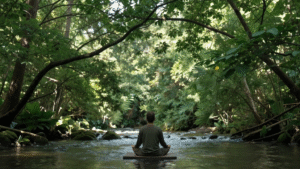Wellness Tourism: Relaxation and Health

Welcome to our blog! Today, we’ll be discussing a topic that has been gaining popularity in recent years, wellness tourism. As more and more people prioritize their physical and mental health, the tourism industry has adapted to meet this demand. But what exactly is wellness tourism, and how can it benefit you? Join us as we explore the world of relaxation and health through travel. Whether you’re a seasoned traveler or simply looking to improve your well-being, this is a topic you won’t want to miss. So sit back, relax, and let’s dive in.
In today’s fast-paced and stressful world, more and more people are seeking ways to find balance and prioritize their well-being. One emerging trend that is gaining popularity is wellness tourism, which combines the elements of travel and self-care. This article will delve into the concept of wellness tourism, its importance, and benefits, and provide a guide on planning a wellness tourism trip.
What is wellness tourism?
A formal definition of wellness tourism:
Wellness tourism can be defined as a form of travel that focuses on enhancing individual well-being through activities and experiences that promote relaxation, rejuvenation, and overall health improvement. It goes beyond simply taking a vacation but centers around self-care and intentional practices contributing to a healthier lifestyle.
The concept of balancing relaxation and health:
At the core of wellness tourism is the idea of achieving a harmonious balance between relaxation and health. It acknowledges that taking care of oneself is not limited to physical health alone but encompasses mental and emotional well-being as well. As such, wellness tourism offers a holistic approach to travel, encouraging individuals to take a break from their routines, destress, and engage in activities that nourish the mind, body, and soul.
Why is wellness tourism important?
Wellness tourism is essential because it provides an opportunity to step away from the demands of daily life and prioritize self-care. It allows individuals to recharge and replenish their energy, which in turn can have a positive impact on their overall health. The importance of wellness tourism lies in its ability to promote a healthier lifestyle, reduce stress levels, and improve overall well-being.
Benefits of wellness tourism
Engaging in wellness tourism can yield numerous benefits for individuals seeking a balanced and healthier lifestyle.
Some of the key advantages include:
Stress reduction: Wellness tourism allows individuals to escape the stressors of daily life and engage in activities that promote relaxation and mindfulness. From yoga retreats to spa treatments, these experiences can significantly reduce stress levels.
Physical rejuvenation: Many wellness tourism destinations offer a plethora of holistic treatments and activities that contribute to physical rejuvenation. From natural hot springs to hiking trails, these experiences can improve fitness levels and invigorate the body.
Mental and emotional well-being: Wellness tourism fosters mental and emotional well-being through activities such as meditation, mindfulness practices, and wellness workshops. These experiences can enhance self-awareness, promote emotional balance, and cultivate a positive mindset.
Cultural exploration: Wellness tourism often takes place in beautiful destinations that offer a blend of cultural experiences. This combination allows travelers to not only focus on their well-being but also immerse themselves in the local culture, thereby enriching their overall travel experience.
Types of wellness tourism
Wellness tourism encompasses a wide range of activities and experiences, catering to different interests and preferences.
Some popular forms of wellness tourism include:
Spa retreats: These destinations offer various treatments, including massages, facials, and body scrubs, aimed at relaxation and rejuvenation.
Yoga and meditation retreats: Ideal for individuals seeking inner peace and mindful practices, these retreats combine yoga, meditation, and wellness workshops.
Fitness and wellness resorts: These resorts provide fitness facilities, wellness programs, and activities such as hiking, swimming, and fitness classes to promote physical well-being.
Nature and eco-wellness retreats: Located in serene natural environments, these retreats offer opportunities to reconnect with nature through activities like hiking, forest bathing, and wildlife encounters.
How does wellness tourism work?
Wellness tourism typically works by offering a range of activities and experiences tailored to promote relaxation, fitness, and well-being. Upon arriving at a wellness tourism destination, individuals can engage in various wellness activities such as yoga, meditation, spa treatments, nature walks, and healthy cooking classes. These activities are often designed to cater to different preferences and fitness levels, ensuring that everyone can participate and benefit from the experiences available.
Factors to consider in wellness tourism
When embarking on a wellness tourism trip, there are several factors to consider to maximize the experience:
Personal preferences and goals: Decide what you hope to achieve from your wellness trip. Are you looking to relax, improve fitness, or focus on mental well-being?
Destination: Choose a destination that aligns with your preferences, whether it’s a tropical beach resort, a mountain retreat, or a serene spa town.
Facilities and services: Research the facilities and services offered at the wellness tourism destination to ensure they cater to your specific needs and interests. Look for reviews, recommendations, and certifications to ensure quality and authenticity.
Budget: Set a budget for your wellness tourism trip, considering accommodation, activities, meals, and transportation costs. Be mindful of any additional expenses that may arise during your stay.
Choosing the right wellness tourism destination
When choosing the perfect wellness tourism destination, consider the following factors:
Destination ambiance: Think about the type of environment that resonates with you. Are you drawn to tropical beaches, mountain retreats, or secluded forests?
Wellness focus: Different destinations may specialize in specific wellness activities or treatments. Consider what type of wellness experience you are seeking, whether it’s yoga, holistic therapy, or nature immersion.
Accessibility: Assess the travel distance and transportation options to ensure the destination is easily accessible and fits within your travel preferences.
Climate and season: Take into account the climate and season of the destination to ensure it aligns with your desired experience. Some people prefer warm weather for outdoor activities, while others may enjoy the coziness of a winter wellness retreat.
Planning a wellness tourism trip
https://serenity7wellness.com/index.php/2023/12/12/the-pillars-of-health-why-it-matters/
To plan a successful wellness tourism trip, it is crucial to pay attention to the following aspects:
1. Researching wellness tourism destinations
Thoroughly research potential destinations that offer wellness tourism experiences. Look for information on activities, accommodations, reviews, and recommendations to make an informed decision.
How to choose the perfect wellness tourism destination:
Consider your wellness goals and preferences.
Read reviews and testimonials from previous visitors.
Look for destinations that align with your preferred wellness activities.
Research the climate and season of the destination.
2. Creating a wellness travel itinerary
Once you have chosen a destination, develop a wellness-focused itinerary that includes a balance of activities and relaxation time. Consider scheduling daily yoga or meditation sessions, spa treatments, wellness workshops, and outdoor excursions.
3. Booking accommodation for a wellness trip
Select accommodations that cater to your wellness needs. Look for places that offer amenities such as yoga studios, fitness centers, spas, and healthy dining options. Consider the ambiance, location, and accessibility to maximize your wellness experience.
4. Choosing wellness activities and experiences
Research the wellness activities and experiences available at your chosen destination. Determine which ones align with your goals and interests, whether it’s yoga classes, meditation workshops, nature hikes, or holistic treatments.
5. Eating well on a wellness trip
Pay attention to your dietary choices during your wellness trip. Opt for nourishing foods that support your well-being, such as fresh fruits and vegetables, whole grains, lean proteins, and plenty of water. Many wellness destinations offer healthy dining options, so take advantage of these offerings.
6. Incorporating relaxation techniques
Make time for relaxation techniques throughout your trip. This could include daily meditation, spa treatments, journaling, or simply taking quiet walks in nature. These practices will help you unwind, de-stress, and promote overall well-being.
7. Maintaining a healthy lifestyle during a wellness trip
While on a wellness trip, strive to maintain a healthy lifestyle beyond the scheduled activities. Get enough sleep, stay hydrated, and incorporate daily physical activity. Remember that wellness is a holistic concept that extends beyond a single vacation.
8. Budgeting for a wellness tourism trip
Set a budget for your wellness tourism trip, including accommodations, activities, meals, transportation, and any additional expenses. Consider the cost of wellness treatments and workshops, as well as the value they add to your overall experience.
Wellness tourism trends and best practices
As the wellness tourism industry continues to evolve, several trends and best practices have emerged to enhance the travel experience.
These include:
Mindful traveling for wellness: Incorporating mindfulness practices during travel, such as meditation, gratitude exercises, and digital detoxes, to enhance the wellness experience.
Sustainability and wellness tourism: A growing focus on eco-friendly practices and sustainable tourism in wellness destinations, including utilizing renewable energy, minimizing waste, and protecting natural resources.
Self-care and Wellness tourism: Recognizing the importance of self-care and providing opportunities for individuals to nourish their mind, body, and soul through activities and experiences tailored to personal well-being.
Mental health and Wellness tourism: More destinations are offering mental health-focused programs, such as stress management workshops and therapy sessions, to address the rising demand for mental wellness.
Wellness tourism destinations to explore
There are numerous wellness tourism destinations around the world that offer unique experiences for travelers seeking relaxation and self-care.
Some popular destinations include:
Bali, Indonesia: Known for its lush landscapes, yoga retreats, and wellness resorts, Bali provides a serene environment ideal for wellness tourism.
Sedona, Arizona: Renowned for its breathtaking red rock formations and spiritual energy, Sedona offers a variety of holistic wellness experiences.
Costa Rica: With its abundance of natural beauty, Costa Rica provides opportunities for outdoor adventures, spa treatments, and eco-wellness retreats.
Iceland: Known for its hot springs, geothermal pools, and pure natural landscapes, Iceland offers unique wellness experiences amidst stunning scenery.
Wellness tourism resources and tools
To enhance your wellness tourism journey, utilize various resources and tools available.
These may include:
Wellness tourism websites and blogs: Explore dedicated websites and blogs that provide information, destination recommendations, and personal stories related to wellness tourism.
Wellness apps: Utilize apps that offer guided meditations, yoga classes, sleep aids, and fitness routines to support your well-being during your travels.
Local recommendations and guides: Seek advice from locals or connect with wellness communities in your chosen destination to discover hidden gems and authentic wellness experiences.
Wrap Up
Wellness tourism offers a unique and holistic approach to travel, providing individuals with an opportunity to prioritize their well-being and find balance in their lives. By combining relaxation and health-focused activities, wellness tourism destinations enable travelers to recharge, rejuvenate, and incorporate healthy habits into their daily routines. Whether you are seeking stress reduction, physical rejuvenation, or mental and emotional well-being, embarking on a wellness tourism trip can be a transformative experience that empowers you to prioritize self-care and enhance your overall quality of life. Explore the diverse range of wellness tourism destinations available, plan your journey mindfully, and embark on a wellness adventure that aligns with your personal goals and interests.
https://globalwellnessinstitute.org/
FAQ’s
1. What is wellness tourism?
Wellness tourism is a type of travel that prioritizes physical and mental well-being. It can include activities like yoga retreats, spa treatments, and healthy eating experiences.
2. How can I incorporate relaxation into my daily routine?
There are many ways to incorporate relaxation into your daily routine, such as taking breaks throughout the day to stretch or meditate, practicing deep breathing exercises, and setting aside time for hobbies or leisure activities.
3. What are some tips for maintaining a healthy lifestyle?
Some tips for maintaining a healthy lifestyle include staying hydrated, eating a balanced diet, getting regular exercise, getting enough sleep, and managing stress.
4. How can I improve my mental health?
To improve your mental health, it’s important to prioritize self-care, practice mindfulness and relaxation techniques, build supportive relationships, and seek professional help if needed.
5. What are some ways to promote environmental wellness?
Ways to promote environmental wellness include reducing waste and recycling, using eco-friendly products, conserving energy and water, and supporting sustainable businesses and practices.





